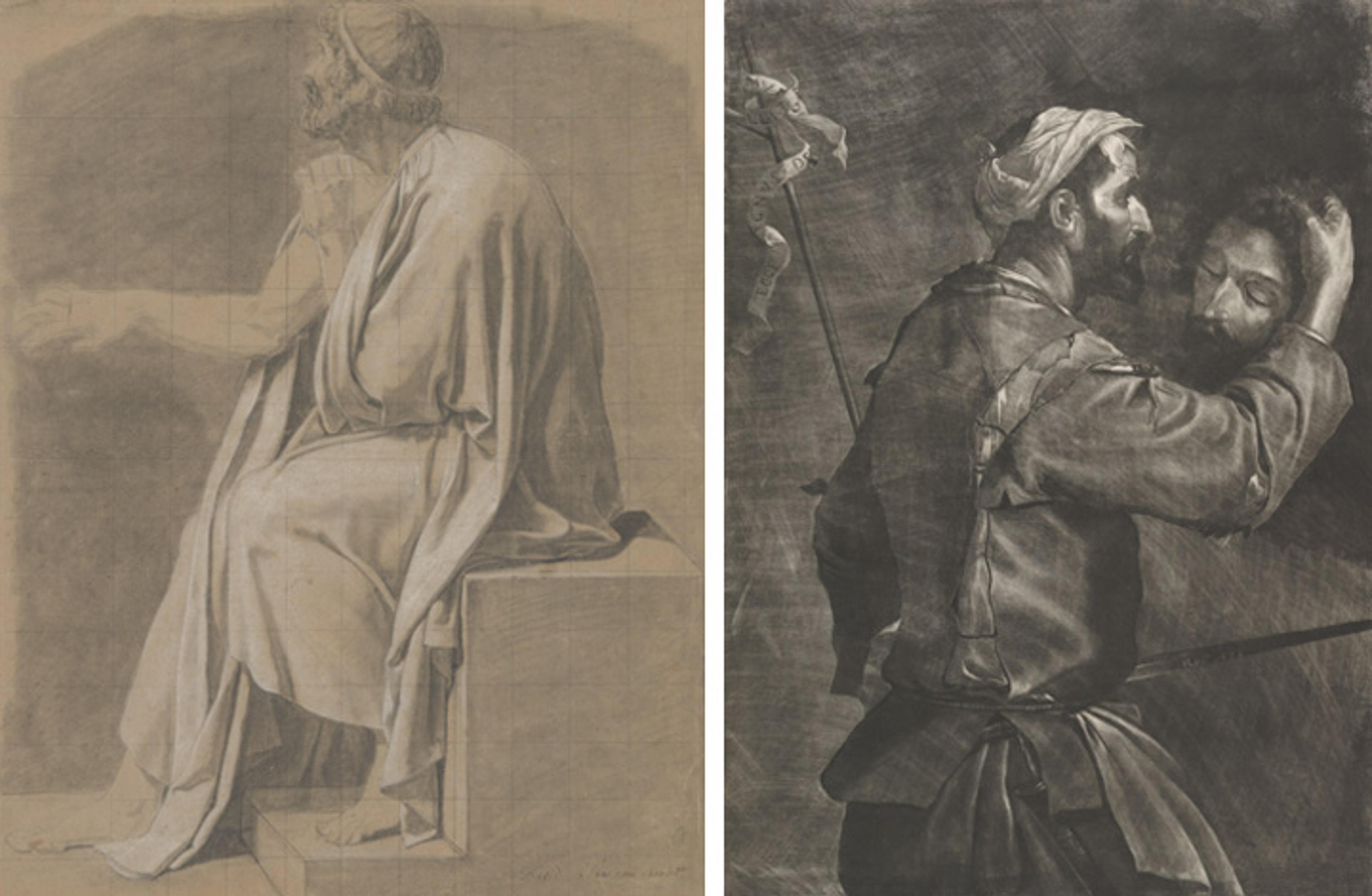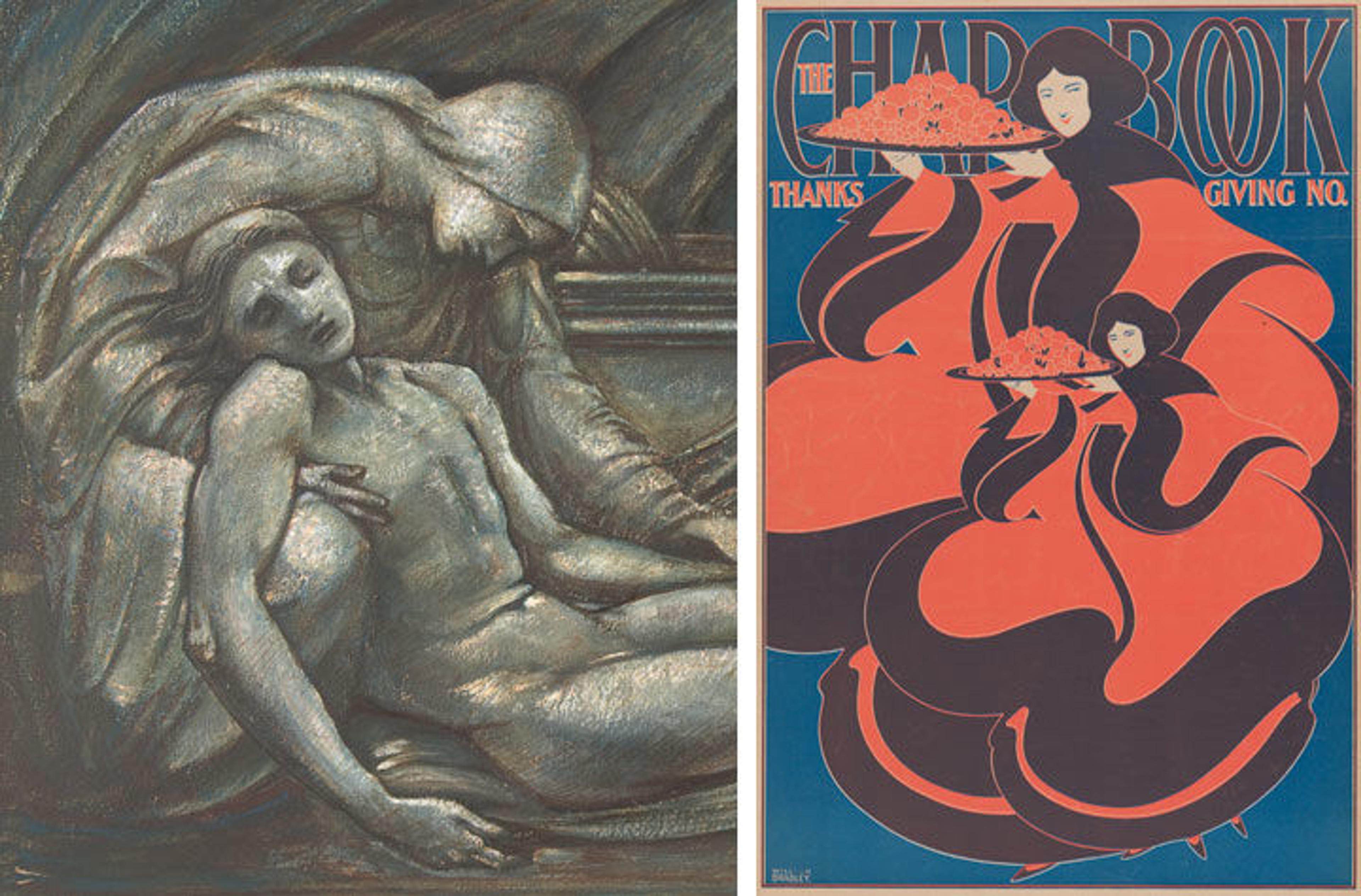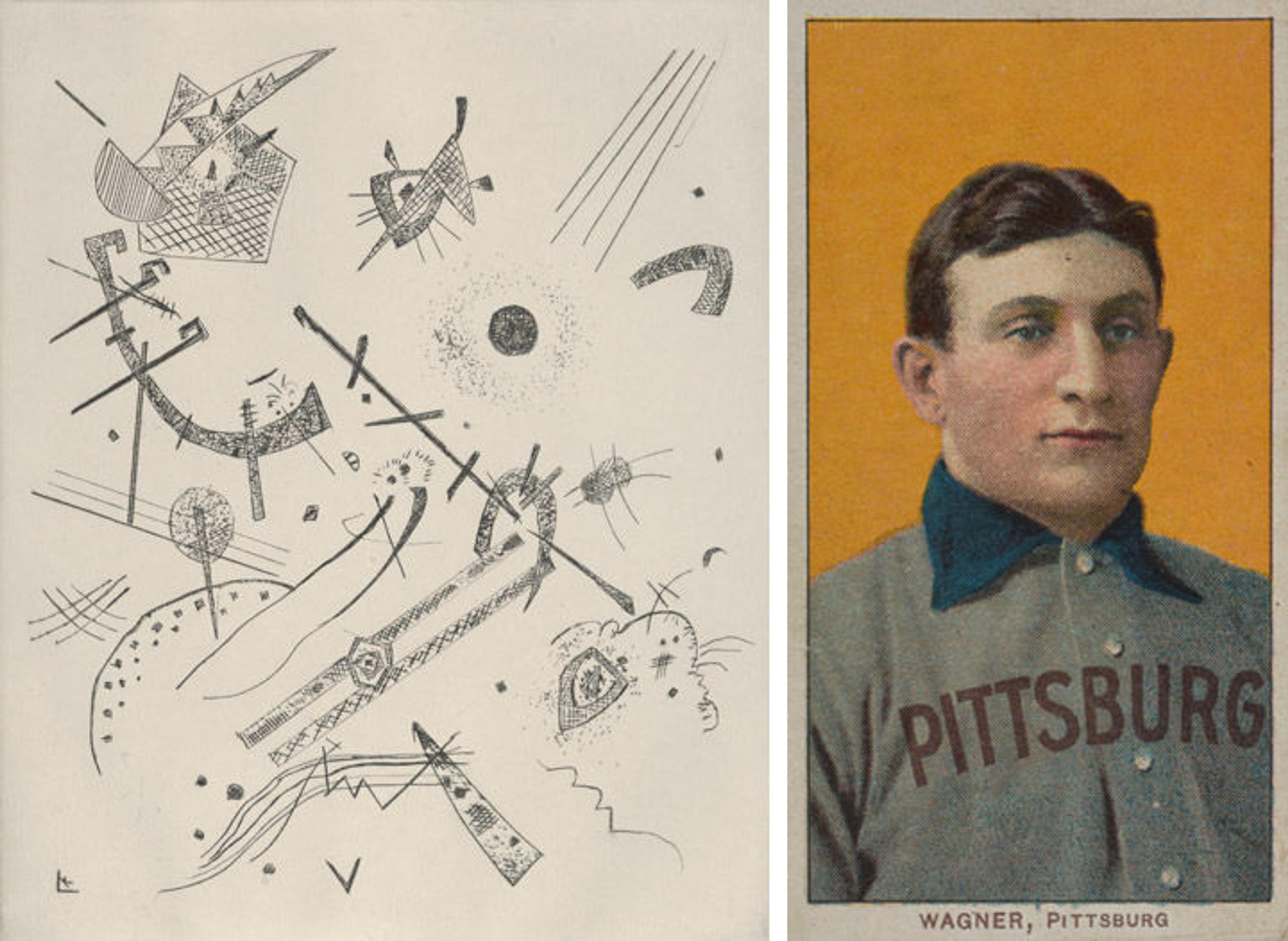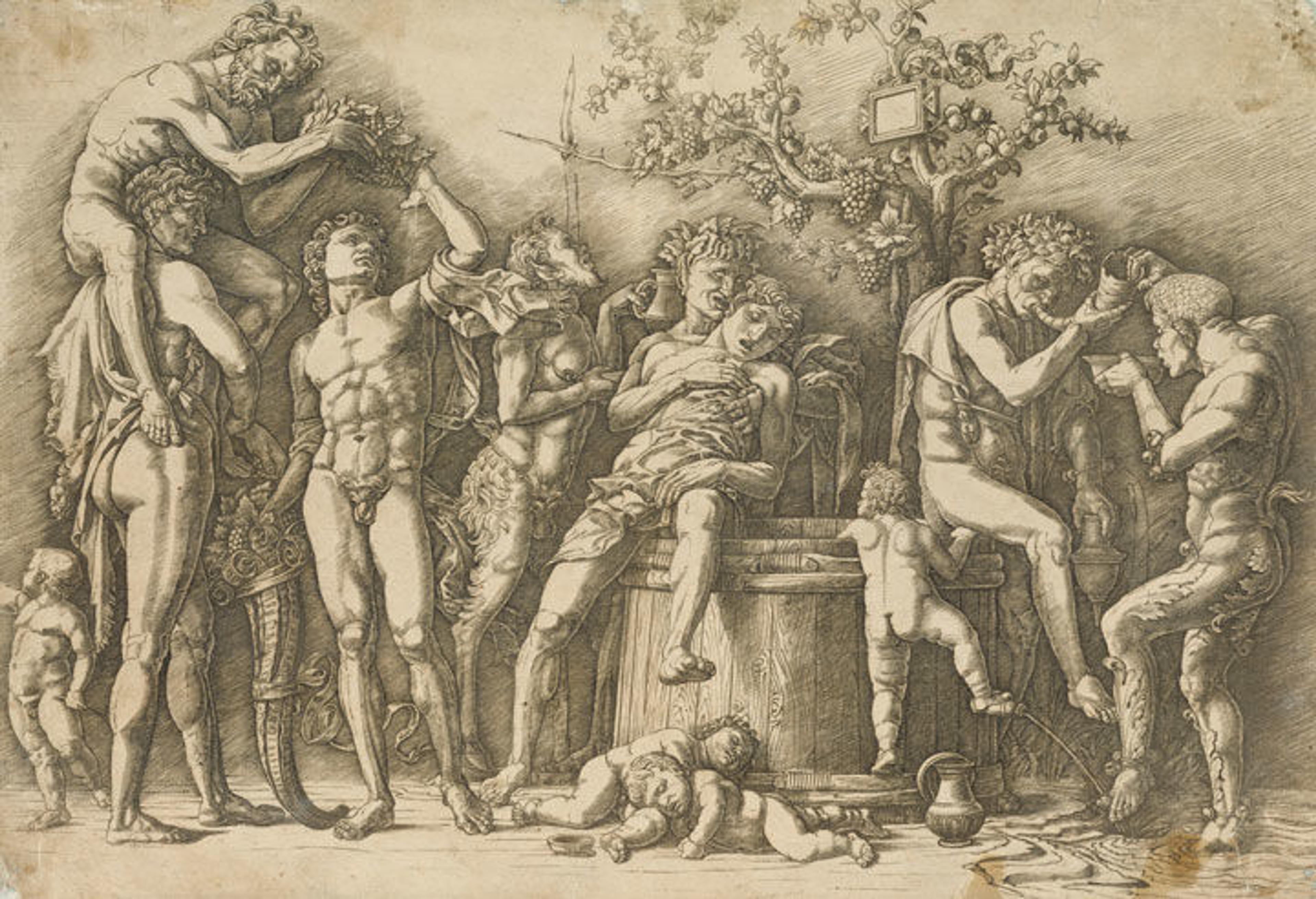Michelangelo and More: Works of the Week Honoring 100 Years of Drawings and Prints at The Met

Left: Jacques Louis David (French, 1748–1825). Figure study for The Death of Socrates, ca. 1786–87. Black chalk, stumped, heightened with white chalk on beige paper; squared in black chalk, 21 1/8 x 16 5/16 in. (53.6 x 41.4 cm). The Metropolitan Museum of Art, New York, Rogers Fund, 1961 (61.161.1). Right: Prince Rupert of the Rhine (Bohemian, 1619–1682). The Great Executioner with the Head of Saint John the Baptist, 1658. Mezzotint with engraving; third state, sheet: 25 x 17 7/16 in. (63.5 x 44.3 cm). The Metropolitan Museum of Art, New York, Purchase, Lila Acheson Wallace Gift, in honor of George R. Goldner, 2015 (2015.43)
«To celebrate the centenary of a curatorial department dedicated to works on paper, The Robert Wood Johnson, Jr. Gallery will feature one highlight per week from the collection of the Department of Drawings and Prints through April 30, 2017. Reflecting the remarkable breadth of the department's holdings, the rotating selection includes drawings and prints, as well as woodblocks, books, cut paper, and ephemera ranging from the early 15th to the 21st century.»
Jacques Louis David's figure study for The Death of Socrates (ca. 1786–87) will be on view from October 25 through October 31. The highly finished drawing is a study for David's painting The Death of Socrates, which hangs in The Met's European Paintings galleries. The sheet is a study for the pose and drapery of Crito, a wealthy Athenian disciple who, in the painting, sits by the ancient Greek philosopher Socrates's side and beseeches him not to drink the hemlock. The grid drawn in black chalk, known as squaring, would have assisted the artist in transferring the design from paper to canvas.
From November 1 through November 7, you'll have the opportunity to view Prince Rupert of the Rhine's The Great Executioner with the Head of John the Baptist (1658). Recently acquired by the Museum, the work is a luscious impression of one of the most ambitious and beautiful mezzotints produced during the 17th century. Invented in Holland in 1642 by Ludwig von Siegen, the mezzotint technique was developed in Frankfurt by Wallerant Vaillant and Prince Rupert, a statesman and soldier connected to the English crown who became fascinated by the new method and created this unsettling image based on a painting from the Ribera school.
Left: Michelangelo Buonarroti (Italian, 1475–1564). Studies for the Libyan Sibyl, ca. 1510–11. Red chalk, with small accents of white chalk on the left shoulder of the figure in the main study, 11 3/8 x 8 7/16 in. (28.9 x 21.4 cm). The Metropolitan Museum of Art, New York, Purchase, Joseph Pulitzer Bequest, 1924 (24.197.2)

Michelangelo's sheet of closely observed life studies is the most remarkable drawing by the artist in a North American collection and an iconic masterpiece. Drawn from a young male assistant posing in the artist's studio, it is a preparatory drawing for the design of the Libyan Sibyl, a monumental enthroned female figure painted by Michelangelo in fresco on the ceiling of the Sistine Chapel at the Vatican Palace. In the fresco, the figure is clothed, except for her powerful shoulders and arms, and has an elaborately braided coiffure. The artist used the present sheet to explore the anatomical elements that were crucial in the elegant resolution of the figure's pose, especially the counterpoint twist of the shoulders and hips and the manner of weight-bearing on her toe. The drawing will be on view from November 8 through November 14.

Left: Sir Edward Burne-Jones (British, 1833–1898). The Entombment (detail), 1879. Green, blue, brown, and touches of reddish gouache, heightened with white gouache on green paper, 12 x 18 3/4 in. (30.5 x 47.6 cm). The Metropolitan Museum of Art, New York, Gift of Mrs. Darwin S. Morse, 1963 (63.200.3). Right: William Henry Bradley (American, 1868–1962). The Chap Book: Thanksgiving Number, 1895. Lithograph, sheet: 20 13/16 x 13 7/8 in. (52.8 x 35.2 cm), image: 19 5/8 x 13 5/16 in. (49.9 x 33.8 cm). The Metropolitan Museum of Art, New York, Leonard A. Lauder Collection of American Posters, Gift of Leonard A. Lauder, 1984 (1984.1202.7)
For one week beginning November 15, you will have the chance to view The Entombment (1879) by Sir Edward Burne-Jones. This design was created for George Howard, the Ninth Earl of Castille, who wished to honor his father's memory with a bronze plaque. The curving forms fill the work's confined space, enclosing the mourners to convey a profound sense of grief that is both Christian and universal.
The Chap-Book: Thanksgiving Number (1895), on view from November 22 through November 28, is a poster designed by William Henry Bradley, a leader of the American art-poster movement of the 1890s. While the use of the poster as a medium for advertising dates to the 18th century, technical advances made in color printing during the 19th century led to new aesthetic possibilities for designers. To advertise the Thanksgiving issue of The Chap-Book, a popular magazine at the time, Bradley chose to depict two women, identical apart from their size, displaying platters of food in celebration of the American holiday, which falls on November 24 this year.

Eugène Delacroix (French, 1798–1863). Arch of Morning Glories, study for Basket of Flowers, 1848–49. Pastel on blue paper, 12 1/16 x 18 in. (30.6 x 45.7 cm). The Metropolitan Museum of Art, New York, Bequest of Miss Adelaide Milton de Groot, 1967 (67.187.4)
Eugène Delacroix's vivid pastel Arch of Morning Glories (1848–49) is a study for another painting in The Met collection, Basket of Flowers (1848–49). Delacroix was experimenting with depicting nature as one would see it in a garden; here, he envisioned a variety of flowers pieced in an unlikely manner within the same frame. Delacroix only depicts one type of flower in this study: a thick, furled arch of white morning glories, which would provide the framework for an upended basket of flowers in the painted version. To effect the organic sprawl of the arch, Delacroix intertwined forest, moss, and chartreuse green pastels, setting them against a pale blue sky. This work will be on view from November 29 through December 5.

Left: Vasily Kandinsky (French [born Russia], 1866–1944). Kleine Welten XI (Small Worlds XI), 1922. Drypoint, plate: 9 5/16 x 7 7/8 in. (23.7 x 20 cm), sheet: 10 1/2 x 11 13/16 in. (26.7 x 30 cm). The Metropolitan Museum of Art, New York, Harris Brisbane Dick Fund, 1931 (31.10.10). Right: Issued by American Tobacco Company. Honus Wagner, Pittsburgh, National League, from the White Border series (T206) for the American Tobacco Company, 1909–11. Commercial lithograph, sheet: 2 5/8 x 1 7/16 in. (6.7 x 3.7 cm). The Metropolitan Museum of Art, New York, The Jefferson R. Burdick Collection, Gift of Jefferson R. Burdick (63.350.246.206.378)
From December 6 through December 12, Vasily Kandinsky's portfolio of prints entitled Small Worlds (Kleine Welten) (1922) will be on view. Kandinsky made this portfolio while teaching at the Bauhaus, the influential German art school founded after World War I. The artist regarded abstraction as a spiritual language, and in these poetic images he creates a vibrant interplay of line and form while capitalizing on the strengths of various printmaking methods—including drypoint, woodcut, and lithography—in order to evoke different sensations or "worlds."
The Honus Wagner baseball card (1909–11) is the rarest object in the vast collection of printed ephemera donated to The Met by Jefferson R. Burdick in the mid-20th century. Commonly referred to as "the T206," it is part of a series of more than 500 baseball cards designated T206 by Burdick, who established the baseball-card cataloguing system still used by collectors today. The American Tobacco Company issued the series to promote 16 brands of cigarettes and loose tobacco. The Wagner card is so rare because the player—a shortstop for the Pittsburgh Pirates widely recognized as one of the best baseball players of all time—requested that the card be pulled from production shortly after it was released. Legend has it that Wagner objected to the use of his visage to advertise tobacco products to children. You can see the Honus Wagner card from December 13 through December 19.

Andrea Mantegna (Italian, 1430/31–1506). Bacchanal with a Wine Vat, ca. 1470–90. Engraving and drypoint, sheet: 11 3/4 x 17 3/16 in. (29.9 x 43.7 cm). The Metropolitan Museum of Art, New York, Purchase, Rogers Fund, The Charles Engelhard Foundation Gift, and The Elisha Whittelsey Collection, The Elisha Whittelsey Fund, 1986 (1986.1159)
In Andrea Mantegna's Bacchanal with a Wine Vat (ca. 1470—90), on view for one week starting December 20, drunken figures gather around the wine vat, populating the space with a funereal majesty. The composition for the engraving was inspired by antique sarcophagi that were in the collections of the della Valle family and in the Church of Santa Maria Maggiore in Rome. While the engraving's composition and sculptural quality reveal Mantegna's fascination with classical antiquity, the unconscious youth's resemblance to the dead Christ in the Pietà also alludes to ancient associations between Bacchic rites and Christian mysteries.
Check back soon on Now at The Met to find out which highlights from the collection we will present next!
Related Links
Drawings and Prints: Selections from The Met Collection, on view at The Met Fifth Avenue from October 25, 2016, through January 30, 2017
MetCollects: "Perrin Stein on The Death of Socrates"
The Jefferson R. Burdick Collection of Printed Ephemera: "Baseball at The Met"
Allison Rudnick
Associate Curator Allison Rudnick manages the Study Room for Drawings and Prints and oversees the ephemera collection. She joined the department as a research assistant in 2012 and has held positions at the print shop Harlan & Weaver and the Whitney Museum of American Art. Active in the field of contemporary printmaking, she is a frequent contributor to Art in Print and serves as treasurer for the Association of Print Scholars. She holds a BA from Connecticut College and an MPhil from the Graduate Center of the City University of New York, where she is a PhD candidate.
Angela Pastorelli-Sosa
Angela Pastorelli-Sosa was formerly a Lifchez-Stronach curatorial intern in the Department of Drawings and Prints.